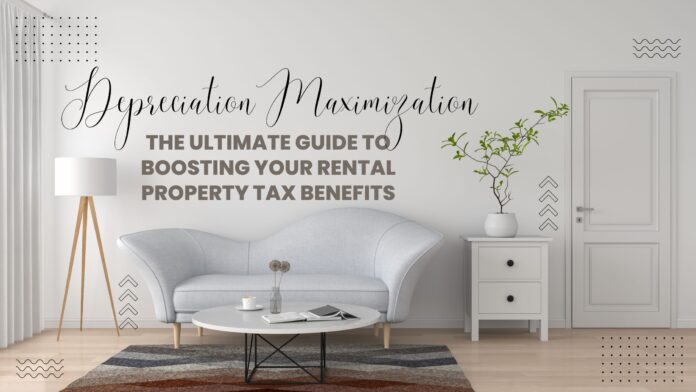Introduction
Rental properties are an excellent source of passive income and long-term wealth-building. Whether you own a single rental asset or an entire portfolio of property rentals, maximizing depreciation is essential to reducing your taxable income and increasing your overall return on investment.
But what exactly is rental property depreciation? And how can you use it to your advantage?
Depreciation is the gradual loss in value of a tangible asset over time due to wear and tear, age, and obsolescence. With rental real estate, you can claim this loss in value as a tax deduction each year on your investment property’s tax return.
This means that even if your rental property increases in value over time, you can still offset some of that appreciation with depreciation deductions. However, claiming rental property depreciation isn’t as simple as subtracting the same amount from your taxable income each year.
Instead, several factors come into play when calculating the correct amount of depreciation for each year. In this article, we’ll explore the ins and outs of maximizing depreciation for rental properties so that you can make the most out of owning an investment property while minimizing your tax liability.

Understanding Rental Property Depreciation
Depreciation is a key component to understanding and maximizing the tax benefits of owning rental real estate.
Depreciation is an accounting method used to allocate the cost of a rental asset over its useful life, allowing owners to deduct a portion of that cost each year on their tax returns. The purpose of depreciation is to reflect the wear and tear, deterioration, or obsolescence of an asset over time.
In terms of investment property depreciation, there are certain aspects that need to be taken into consideration. These include the type of property rental asset being depreciated (i.e. residential or commercial), its estimated useful life (which varies depending on the type of asset), and whether any improvements have been made that can be depreciated separately from the property itself.
It’s important for rental property owners to have a good understanding of these factors in order to maximize their tax deductions and minimize their taxable income. Additionally, it’s important for owners to keep accurate records so they can properly calculate their annual depreciation expenses.
How to Maximize Depreciation for Rental Properties
Depreciation is one of the most significant tax deductions available to property owners who rent out their real estate. It reduces taxable income by accounting for the wear and tear on rental assets over time. There are various ways to maximize depreciation, which can help rental property owners reduce their tax bills and increase their net profit.
One strategy to maximize depreciation is to know the right asset classifications. Rental real estate generally has a lifespan of 27.5 years, while certain items inside the rental property may have a shorter useful life and can be depreciated more quickly.
For instance, appliances or carpeting can be written off over five years, whereas items such as roofs or windows have a useful life of 20 years or more. Identifying these distinctions can significantly increase your total depreciation expense, which will lower your taxable income and provide you with greater cash flow in the short term.
Another way to maximize depreciation is through cost segregation studies. Cost segregation is an advanced accounting technique that allows you to separate assets into various categories with different depreciation rates that align better with reality than standard asset classes used by IRS codes.
This technique allows you to accelerate depreciation by identifying components of your investment property that may not be explicitly defined in IRS regulations but could still qualify for accelerated depreciation under rules around bonus depreciation, section 179 deductions or other specialized provisions provided by tax code updates. By using cost segregation studies in combination with conventional asset classifications from IRS guidelines, many real estate investors find they receive much larger total tax deductions than before, potentially saving thousands on taxes annually while increasing cash flow significantly over time as well!

Tax Benefits of Rental Property Depreciation
Depreciation is one of the most advantageous tax benefits associated with rental real estate. By being able to deduct a portion of the property’s value each year, property rental owners can significantly reduce their taxable income. This means that they will have more money to reinvest in their rental assets or use for personal expenses.
Additionally, rental property depreciation can help mitigate the effects of inflation on a property owner’s income. Another tax benefit of depreciation for investment properties is that it can offset any passive income generated by the property.
Passive income includes income from sources where the individual is not actively involved in generating or managing, such as rental income. By deducting depreciation from passive rental incomes, investors can avoid paying taxes on a significant portion of their profits.
Additionally, if an investor incurs losses on their rental assets, such as repairs and maintenance costs exceeding rental income, they can use these losses to offset taxable gains from other investments or sources of income. It is important to note that while depreciation provides significant tax benefits to investment property owners, it does not erase the need for proper financial planning and management.
Rental real estate owners should still track all expenses related to their properties and maintain accurate records of depreciation deductions taken each year. They should also consult with a qualified professional such as an accountant or tax specialist for advice on how best to take advantage of all available tax deductions associated with their investment properties.
Calculating Depreciation for Rental Properties
To calculate depreciation for rental properties, you will need to determine the property’s useful life and its cost basis. The useful life refers to the number of years that a rental property can be expected to generate income before it needs significant repairs or replacement.
The cost basis includes the purchase price of the property, closing costs such as title insurance and attorney fees, and any improvements made to the property. To determine the useful life of a rental property, you can refer to IRS Publication 946, which provides guidelines for determining the depreciation period for different types of assets.
Generally, residential rental properties have a useful life of 27.5 years while commercial rental properties have a useful life of 39 years. Once you have determined the useful life and cost basis, you can use a depreciation chart or calculator to determine the annual depreciation expense.
It is important to note that only structures such as buildings and improvements are depreciable assets, not land. Therefore, when calculating depreciation for rental properties, you should separate land value from structure value.
You can do this by using an appraisal or other methods such as referring to public records or consulting with real estate professionals in your area. By accurately calculating depreciation for your rental property, you can maximize tax deductions on your investment property while ensuring compliance with IRS regulations.

Common Mistakes in Calculating Depreciation
One of the most common mistakes landlords make when calculating depreciation for their rental properties is failing to allocate the proper amount of costs to land and buildings. This mistake can lead to overestimating the depreciable basis, which reduces the amount of depreciation that can be claimed each year.
Land is not depreciable, so it’s important to determine its value accurately in order to reflect the correct basis in the property. Another error that landlords commonly make is failing to adjust their depreciable basis for any improvements made to the property throughout its useful life.
When a landlord makes an improvement, such as adding a new roof or installing new carpeting, this cost should be added onto the property’s basis and depreciated over time. Failing to do so can result in underestimating depreciation expense and missing out on valuable tax deductions.
Another common mistake is forgetting about recapture of depreciation when selling rental assets. If you sell a rental property at a gain, you may be required to pay back some or all of your accumulated depreciation through something called depreciation recapture.
This can be an unexpected expense if you didn’t plan for it when calculating your taxes and could potentially wipe out some or all of your profit from selling the property. It’s important for landlords to keep accurate records of their rental assets and consult with a tax professional before making any significant changes or transactions with their investment properties.
Depreciation Recapture and Its Impact
Depreciation recapture is something that every property owner who has claimed depreciation on their rental assets should be aware of. This term refers to the process by which the IRS requires property owners to pay back a portion of the tax deductions they have claimed on an investment property when it is sold.
Depreciation recapture can have a significant impact on your tax liabilities, so it’s important to understand how this process works. The amount of depreciation recapture you will owe depends on several factors, including the amount of depreciation you have claimed over time and your marginal tax rate at the time of sale.
If you sell a rental property for more than its adjusted basis (which is calculated by subtracting accumulated depreciation from the original cost of the asset), you may be required to pay back some or all of the tax deductions you claimed on that property during its useful life. This additional income can push you into a higher tax bracket, which can result in a larger overall tax liability.
It’s important to work with an experienced tax professional who can help you navigate these complex calculations and minimize your overall liability when selling rental real estate. Understanding how depreciation recapture works is essential for anyone who owns or plans to own rental properties.
By working with an experienced accountant or tax professional and staying up-to-date on changes in relevant laws and regulations, you can maximize your returns while minimizing your risk and liabilities associated with investment property ownership. Remember: proper planning and preparation are key to success in any endeavor, including property rental!
Conclusion
Maximizing depreciation for rental property is a crucial component of managing a profitable investment property portfolio. The tax benefits of rental property depreciation cannot be overstated, and with careful planning and calculation, investors can take full advantage of this valuable tax deduction. By understanding rental property depreciation, calculating it accurately, avoiding common mistakes, and considering the impact of depreciation recapture, investors can maximize their deductions and reduce their taxable income.
Moreover, by increasing the amount of depreciation taken each year through cost segregation studies or other methods allowed by the IRS, investors can further reduce their tax burden while simultaneously increasing their cash flow. Ultimately, investing in rental real estate is a smart move for those seeking long-term wealth accumulation.
By maximizing rental property depreciation, investors can further increase their profits while building tangible assets that will appreciate over time. Investing in investment properties is not without its challenges; however, with the right tools and knowledge at your disposal (such as those discussed in this article), you too can become a successful landlord with profitable rental assets.
As you continue your journey to optimize your business tax strategy, why not consider the untapped potential within your own family? Delve into the Tax Benefits of Hiring Your Children in Your Business to discover how this strategy could turn family time into a significant financial advantage. But don’t stop there; explore how you can further maximize your tax savings with accountable plans as a tax strategy for small business owners, a goldmine of tactics designed for those serious about streamlining their fiscal strategies. Your path to savvy tax management is just a click away.










